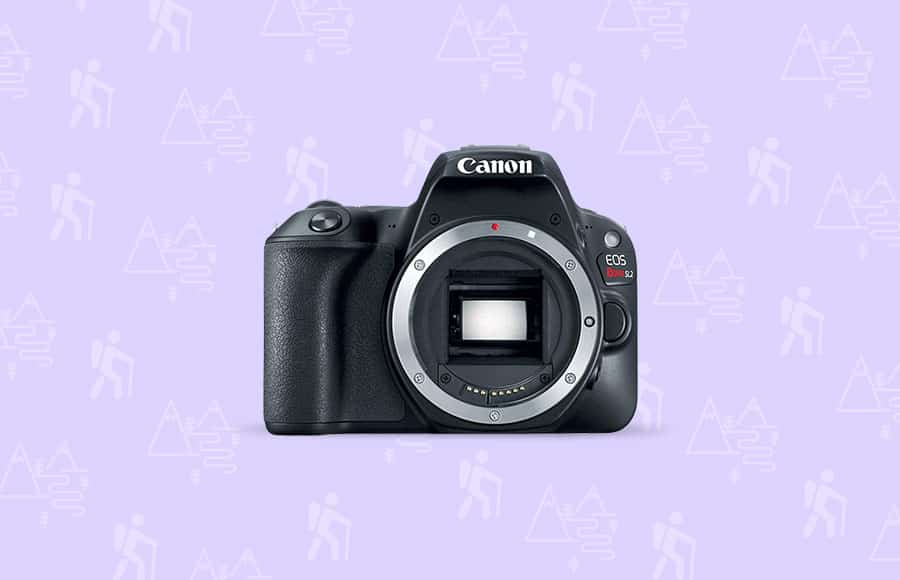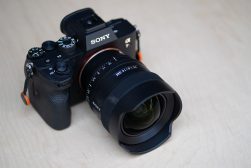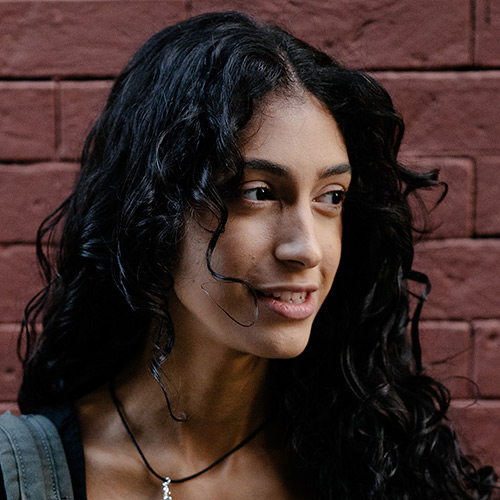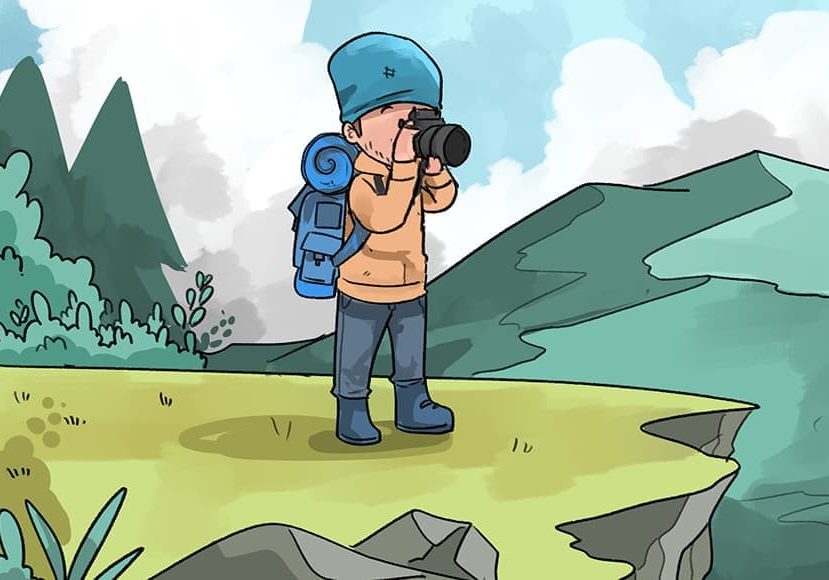
Best Camera for Hiking and Backpacking in 2024
Planning your next hiking or backpacking adventure? Make sure you return home with some beautiful landscape images with one of these top cameras.
If you’re looking for the best camera for hiking, I’m guessing you spend a lot of time in the great outdoors – how I envy you!
Being able to go for walks in the countryside or hike up the side of a mountain is one thing, but being able to capture it in all its glory is the icing on the cake.
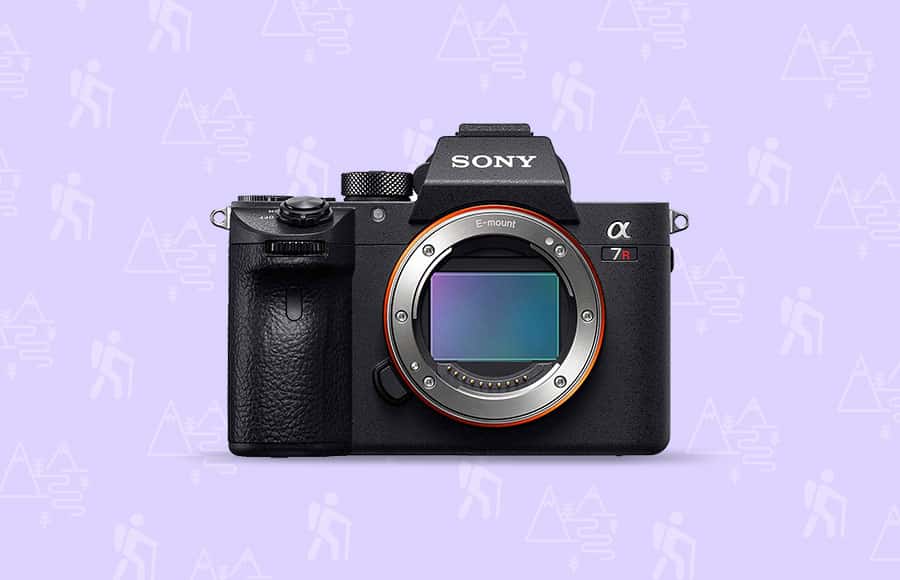
Capture stunning scenes from your hiking adventures with the world's first 61MP full frame sensor.
This is a guide to choosing the right hiking camera for capturing every amazing landscape you encounter on your hiking and backpacking adventures.
I’ve included a couple of more affordable options for those just starting out in photography, or with limited budgets – you can certainly get some great photos without breaking the bank.
Let’s have a closer look at some of the top cameras for hiking this year.
You should also check out our guide to the best camera harnesses for hiking.
Best Camera for Hiking in 2024
| Image | Product | Features | |
|---|---|---|---|
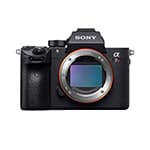 | Sony a7R IVBEST ALL ROUND |
| View Price → |
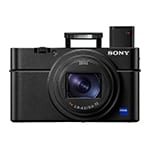 | Sony RX100 VIIBEST COMPACT |
| View Price → |
 | Olympus TG 6BEST WATERPROOF |
| View Price → |
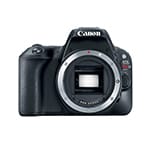 | Canon Rebel SL2 |
| View Price → |
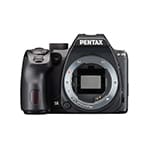 | Pentax K-70 |
| View Price → |
 | GoPro Hero8 |
| View Price → |
1. Sony a7R IV
Sensor: Full-frame | Resolution: 61MP | Viewfinder: 5,760K dots | Monitor: 3-inch tilt-angle touchscreen, 21,400K dots | Autofocus: 567 Phase + 425 Contrast detection points | Max frame rate: 10fps | Video: 4K at 30p | Weight: 665 g (1 lb 7.5 oz)
To many, the Sony a7R IV is the best camera for hiking.
For superior image quality in a portable package, the Sony a7R IV is easily the best camera for hiking and backpacking. It’s the lightest and most compact high-resolution camera on the market, and its 61MP BSI-CMOS sensor delivers stunning image quality across the board.
At less than 2 lbs, the Sony a7R IV is quite manageable for most hiking and backpacking endeavors.
In fact, if you pair it with prime lenses you’ll be amazed at how small your camera gear kit will be.
Wide angle zooms like the Sony 16-35mm are a bit heavier but still make for a lighter kit than a comparable DSLR + lens.
If you’re a landscape or macro shooter and want more than 61MP, the a7R IV’s Pixel Shift mode will get you up to a whopping 240MP! You’ll need a tripod for this though, as any movement in the frame will disrupt the image.
For wildlife shooters, the a7R IV comes with an improved version of Sony’s famous AF tracking system. If you’ve never used it before, prepare to be amazed.
This top-of-the-line mirrorless camera also manages a 10fps burst mode with full autofocus, despite its high resolution.
Another plus is the Sony a7R IV‘s in-body image stabilization. As long as you’re not using the Pixel Shift mode, you can often get by without using a tripod – even at the blue hour. And let’s face it, even the lightest of travel tripods are going to add unwanted weight to your pack.
Though not a fully waterproof camera, the weather sealing on the a7R IV is far improved over the previous generation. The build is also more solid.
One of the key improvements is the placement of the buttons and dials, which are now easier to handle with gloves. It also has excellent battery life – the best on this list by far.
For video shooting, this camera has 4K video both with the full-frame sensor or with an APS-C crop. The latter has more detail, but both come out as high quality.
The only real downer with the Sony a7R IV is the price – at just under $3,500 it’s not cheap.
If that’s a bit much for you, you might want to consider its predecessor, the a7R III (42.4MP). Its price has come way down and is now just a bit more expensive than the popular Sony a7 III.
Alternatively, if you need something that weighs less and is far less expensive, take a look at the Sony alpha series, specifically the Sony alpha a6500 or even the a6000. Both are solid hiking and backpacking mirrorless cameras in their own rights and are much smaller and lighter than the Sony a7R IV.
Still, what makes the Sony a7R IV the best mirrorless camera for hiking and backpacking is its insane resolution and superb image quality all in such a portable package.
Combined with its excellent low-light ability, easy handling, and fantastic overall performance, the a7R IV is now the camera to beat in 2024 for serious outdoor photographers.
2. Sony RX100 VII
Sensor: 1.0″ Exmor RS® CMOS sensor | Resolution: 20.1MP | Viewfinder: 2,359,296K dots | Monitor: 3-inch tilt-angle touchscreen, 921,600K dots | Autofocus: 357 phase-detection and 425 contrast-detection points | Max frame rate: 20fps | Video: 4k HDR (HLG) | Weight: 302g (10.7 oz)
Needing to go ultra-light but still want superior image quality? If so, the Sony RX100 VII is where it’s at. This is the best camera for backpacking for many in the industry.
This little compact camera is nearly legendary for its stellar autofocus performance, fantastic image quality, and extreme versatility, all in a compact form that can literally disappear in your hand.
The Sony RX100 VII’s 1″ sensor gives it much better low-light capabilities than a smartphone while offering many of the camera features valued by pros.
It comes with a versatile 24-200mm f/2.8-4.5 optical zoom lens, allowing you to capture everything from wide-angle landscapes to telephoto shots of wildlife – all in a camera not much larger than a pack of cards.
It even manages to pack an electronic viewfinder into the package.
Speaking of wildlife photography, the RX100 VII has an astounding 20fps burst mode. Wow!
It also comes with the same industry-leading autofocus technologies present in the Sony a7R IV and A9 – including Sony’s famous face and eye-tracking that works with both human and animal subjects.
If you vlog on the trail, the RX100 VII’s articulating touch screen and microphone jack makes vlogging easy. The 4K video comes with all the standard features (like HGL) and looks great, especially when paired with its built-in image stabilization.
While not weather-sealed, the Sony RX100 VII stands up to regular wear and tear just fine.
Also, if you’re into underwater photography, there are a number of waterproof housings specifically designed for the RX100 VII that turn it into an excellent diving camera.
Ultimately the Sony RX100 VII is one of the best compact cameras for those needing a lighter alternative to their pro setup. It offers the best in portability while making the fewest compromises in quality and features.
For some, the RX100 VII’s autofocus capabilities, image quality, video ability, and range of features all packed into a tiny form factor make it the best backpacking camera out there.
The only downside to this little beauty is the cost – at just under $1,200, it prices itself out for many.
But just as with the Sony a7R IV, the previous RX100 models are no sluggards. So if the Sony RX100 VII is out of your range, try looking into the RX100 V or VI, both of which are excellent cameras for hiking in their own right.
3. Olympus TG-6
Sensor: 1/2.33 in | Resolution: 12MP | Monitor: 3.0-inch touchscreen, 1040K dots | Autofocus: 25-points | Max frame rate: 20fps | Video: 4K at 2160p | Weight: 253g (2.12 oz)
If you’re tough on cameras and camera gear or really just don’t want to worry about breaking your investment on the backpacking trail, take a look at the Olympus TG-6. It’s considerably lighter than a mirrorless camera, fully weather-sealed, and virtually indestructible. This might be the best hiking camera for your needs.
A truly waterproof camera, the Olympus TG-6 can be submerged down to 50 feet.
It’s also dustproof, shockproof, able to withstand temperatures down to -10C, can be dropped up to 7 feet (2m), and is crushproof up to 220lbs (99kg).
The TG-6 comes with a versatile 25-100mm f/2.0 zoom lens that has decent image quality and strong low light performance, especially underwater. In fact, many consider it to be the best compact camera in its class for underwater photography.
The 1″ sensor is only 12MP, but Olympus has a talent for pairing low megapixel sensors with lenses that work exceptionally well.
The result is sharper, more detailed images than what many 16 and 20MP compact cameras can produce.
Unlike many compact cameras in this price range, the Olympus TG-6 comes with an automatic microscopic stacking function that produces stunning macro photos.
At times, it even works better than a dedicated macro lens on a DSLR.
While not the strongest video compact camera out there, the Olympus TG-6 does produce crisp, bright footage in both 4k video and in HD.
The image stabilization doesn’t quite match the GoPro’s, but at this price point, it’s amazing that it has it at all.
Other backpacking features include a decent battery life (340 shots per charge), GPS, pressure and temperature sensors, and even a compass.
One thing to keep in mind is that the default settings of the TG-6 are a bit lacklustre. You’ll need to get into the custom settings to get the highest quality images, especially if you shoot in JPEG.
What makes the Olympus TG-6 the best camera for outdoors, however, is the fact that it’s next to indestructible.
Whether you’re ice climbing, kayaking, or backpacking along the PCT, you’ll never have to worry about breaking it.
And, at less than $400 it won’t break the bank, either.
4. Canon Rebel SL2
Sensor: APS-C | Resolution: 24.2MP | Viewfinder: 0.87x magnification pentamirror| Monitor: 3-inch vari-angle touchscreen, 1.04K dots | Autofocus: 9 points | Max frame rate: 5fps | Video: Full HD 1080p at 60fps | Weight: 453g (15.98 oz)
If you prefer a DSLR while hiking and backpacking, the Canon EOS Rebel SL2 is a solid entry-level choice. Weighing in at less than a pound, the SL2 beats out many mirrorless cameras in terms of lightness, form factor and overall portability. This is one of the best cameras for hiking DSLR according to its fans.
One of the tiniest DSLR cameras on the market, the Canon EOS Rebel SL2 manages to incorporate Canon’s high-end DIGIC 7 processor chip, Dual Pixel autofocus in Live View, and even a small viewfinder.
It’s designed to be a step up for smartphone users and comes with a Feature Assistant to help in learning the different controls.
While the number of autofocus points on the SL2 isn’t particularly stunning, it performs quite well for landscape photography.
The low light performance is also decent, both in terms of autofocus and in terms of noise (up to ISO 3200).
While lacking 4K video, the full HD video has a number of options, and the external mic jack and articulating LCD screen make vlogging easy. (If 4k video is really important to you, the slightly more expensive Canon EOS Rebel SL3 offers it.)
While the lack of weather sealing and the mediocre battery life might deter some enthusiasts, those wanting a DSLR to take with them into the backcountry won’t be able to ignore the SL2’s tiny size and incredible portability.
The price is right too. You can now buy an SL2 with a kit lens for around $500. The camera body alone can be found for around $450.
Definitely one of the most affordable interchangeable lens cameras available.
It also opens the door to the immense landscape of fine Canon lenses available, making the Canon EOS Rebel SL2 perfect for new users looking to get into the Canon world.
It’s also great for those who already have a Canon DSLR and are just looking for a lighter hiking camera.
The final word? The Canon EOS Rebel SL2 is your best bet for a lightweight hiking or backpacking DSLR.
It’s especially good for beginners and also makes for a good secondary camera for pros. Just make sure to get a storm jacket for it if you plan to have it out in inclement weather.
5. Pentax K-70
Sensor: APS-C | Resolution: 24.2MP | Viewfinder: 100% field of view; 0.95-times magnification | Monitor: 3-inch, 921K dots | Autofocus: 11 points | Max frame rate: 6fps | Video: Full HD 1080p at 60fps | Weight: 688g (2 lbs)
Another great backpacking DSLR option is the Pentax K-70. At just under $650, it’s packed full of features well beyond its price point.
To begin with, the Pentax K-70 has a solid build, is fully weather-sealed, and has an ergonomic design that includes external controls for all common camera settings. It’s the heaviest camera on this list at 2 lb, but the weather sealing and rugged build make it well worth it as a backpacking camera.
Along with common features like in-body image stabilization, the Pentax K-70 comes with a few perks you just won’t find in the average camera.
The most remarkable of these is its night vision mode and a unique AstroTracer feature that synchronizes the movement of stars with the camera’s sensor.
There’s also a built-in intervalometer for time-lapse photography.
As far as image quality is concerned, the Pentax K-70 has quite a fan club. Many say that its image quality exceeds that of Canon and Nikon cameras in the same price range.
It has an excellent dynamic range and great low light performance, with little noise up to ISO 6400.
There’s also no anti-aliasing filter, so images come out clean and crisp with lots of fine detail.
Another surprise at this price point is the K-70’s pixel shift high-resolution mode. It can really turn out some stunning images when shooting motionless subjects.
Some even claim that the image stabilization functions so well that they can use the pixel shift technology without a tripod.
The only real drawbacks to the K-70 are its weight, mediocre battery life (though better than the Canon EOS Rebel SL2’s), and the fact that battery charging is via an external charger, not a USB cable.
Otherwise, the Pentax K-70 is one of the better cameras for hiking and backpacking, especially if you’re a lover of astrophotography.
It’s rugged, built to last, and a pleasure to use. Just be sure to use a newer lens with it to keep the AF as fast as possible.
6. GoPro Hero8
Sensor: 1-inch | Resolution: 12MP | Monitor: 40mm touchscreen | Video: 4K at 60fps | Weight: 116g (4.1 oz)
No list of cameras for backpacking and hiking would be complete without mentioning the GoPro Hero series.
GoPros have been the industry standard for outdoor action photography since they came out in 2004. Today they’re still the best in their class.
Although best known for their video capabilities, these little cameras offer some surprisingly useful – though unusual – still photography options.
Although there’s a Hero 9 here in 2024, the best bang for your buck iteration is actually the GoPro Hero 8, a tiny, rugged, waterproof camera that allows you to get into places that most cameras can’t reach.
It’s set up to be fully automated but will let you change a few factors like ISO, shutter speed, and whether to shoot in RAW or JPEG.
It comes with a 1″ 12MP sensor – the same as the Olympus TG-6 point-and-shoot.
The lens is a wide angle that stays open at f/2.8.
There’s no optical zoom. Instead, you can choose between three “fields of view”: wide (16-34mm fisheye), linear (19-39mm standard), and narrow (27mm).
The linear and narrow options are the results of software manipulation, not optics, so they only work as JPEGs. For shooting in RAW, you’ll need to keep it on wide.
This might all seem incredibly limiting – and it is if you’re only thinking in terms of traditional photography.
If, however, you’re looking to capture wide expanses while backpacking with a tiny, relatively indestructible and waterproof camera, the GoPro Hero 8 is nothing to be scoffed at.
The Olympus Tough TG-6 is a bit more rugged (i.e, it’s waterproof down to 50 ft. compared to the GoPro’s 33 ft.), but it’s considerably larger and heavier. It also doesn’t do as well in Auto mode.
They do share the same sensor size, however, so the image quality in lower light will be comparable.
Obviously, the Hero 8 excels in video. In 4K or 2.7K, you can shoot at 100 Mbps with an HEVC h.265 codec.
If you’re not out on the trail you can even livestream in 1080p. (See our guide which explains what GoPro LRV and THM files are used for if you’re curious about these files that’ll appear next to each Mp4 video file.)
One place where the GoPro Hero 8 blows everyone out of the water, however, is its in-camera image stabilization. No other camera on this list comes close to it – it’s truly gimbal-like.
Other features of the GoPro Hero 8 include a hyperlapse mode called “Timewarp,” an HDR mode called “SuperPhoto,” and a new LiveBurst mode which captures images 1.5 seconds before and after you press the shutter button.
There’s also a touchscreen, voice command ability, and WiFi – even the best GoPro alternatives don’t offer all this at the same price point.
Unlike the other cameras on this list, the GoPro Hero 8 can be mounted just about anywhere. On a ski trip? Mount it to your helmet. Peak bagging? It will easily mount to your backpack. Kayaking? Mount it to the prow.
Whatever gear you have, there’s probably some way to mount a GoPro to it.
The battery life on all GoPro cameras is pretty limited – just an hour when doing video – so expect to need to recharge it (via USB).
That’s a bit disappointing but not necessarily a deal-breaker if you like its results, especially at a price tag of less than $400.
In the end, if you’re wanting a traditional still camera, the GoPro Hero 8 is probably not for you.
If, however, you’re into capturing action and/or documenting extreme outdoor sports, then it’s seriously worth looking into.
And at just 4 oz, you won’t even feel the weight.
Frequently Asked Questions
What is the best camera for outdoor photography?
If you’re heading outdoors to go hiking, the Sony a7R IV is our top pick for a camera to take with you. With a 61 megapixel full-frame sensor, it’s powerful as well as lightweight.
How can I protect my camera while travelling?
To protect your camera while travelling – especially if you’re outdoors hiking – invest in a good camera bag or backpack that’s sturdy and weatherproof. Carry a rain shield for shooting in inclement weather, and always be careful of dust while changing lenses outdoors.
Are mirrorless cameras better than DSLR?
The advantage of mirrorless cameras over DSLRs is that they’re generally smaller and lighter. For hiking and backpacking, this can make carrying your gear much easier.
Is GoPro good for hiking?
The GoPro Hero 8 is a good option for hiking and backpacking, especially if you’re into adventure and sports photography. It’s small, feature-packed, and affordable.

Capture stunning scenes from your hiking adventures with the world's first 61MP full frame sensor.







